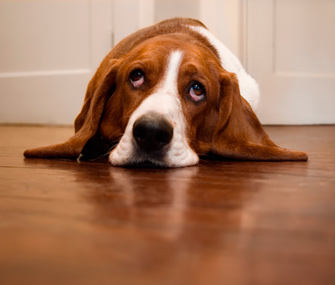What is it about so many canine faces that makes them seem so sad? Drooping ears, lids and lips, soulful eyes and a mournful demeanor — we’ve all seen that look. Is it any wonder that we worry if our beloved canine companions could somehow be sad despite all our efforts to give them the very best we can? Let’s take a look at this conundrum. There might be some very good reasons why an otherwise happy pooch might sometimes seem like a droopy dog.
Of course, it’s very important to be able to differentiate a simple case of sad eyes from a pet who actually might be in pain and have a medical problem. If your pet seems unusually lethargic or depressed or he is exhibiting any signs of pain, please call your veterinarian immediately.
It’s in the DNA
For starters, though, when people began breeding dogs selectively for certain physical traits, we were able to greatly alter a dog’s appearance. Through selective breeding we have been able to fine tune for long ears, short legs, a flatter face, droopy ears, short hair, long hair, no hair, etc. Sometimes, without intentionally doing so, our designer dogs can appear to have a sad face. For example, consider the face of a Basset Hound — long ears, folds of skin, a low-set head and sad eyes that seem to swim in almost a cartoon soup of mournfulness. And what about the beloved French Bulldog? His short muzzle and big, wide eyes make him look like a perpetually worried puppy.
Breed traits aside, sometimes it is our own perception of deferential signaling that makes us think our dog is feeling sad. For example, when our dog looks up at us with his ears pulled back and his eyes intensely staring into ours, we may think he looks sad or upset. In reality, a dog will pull his ears back in response to a person looking at and speaking to him. Some dogs may even lower their heads slightly or open their mouths to pant. This is a normal, appropriate response from a dog to his owner or another person paying attention to him and should not be interpreted as sadness.
Also, never forget how smart and adept our dogs can be at exhibiting a learned behavior. Many dogs quickly learn that if they look a certain way, they will receive more attention from their beloved owners. If your dog likes the additional attention, he may then exhibit this behavior more often. Just as a child may learn to stick out her lower lip and widen her eyes to look sad in order to receive attention from her parents, our dogs may learn how to “manage” us for optimal interaction.
Finally, in other cases, our own guilt may lead us to interpret our dog’s otherwise normal demeanor or behavior as sad. Quite often when I am busy on my computer, I look down at my dog who is resting quietly with his head on his front paws, a pillow or even my feet, and I feel guilty for not paying more attention to him. We need to be rational, however, and realize that our dogs often act exactly the same way after they have come in from a nice long walk or an active play session outside. One helpful way to determine what is guilt vs. reality is to keep a photo journal of your dog’s body language after he has had a “happy” experience, such as a walk or a play session. When he rests quietly after these events, compare those pictures to the ones you take when you think he looks “sad.” Most likely, your dog’s body language in these pictures will appear quite similar — and you can feel a little less guilty.
More On Vetstreet:
